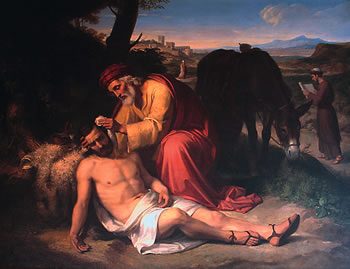Who Are You, Jesus?

Fr Tom Ryan sm
3. A Compassionate Saviour
The Jesus of Luke’s Gospel is presented as the compassionate and universal Saviour. From the many parables on this theme, let’s focus on the Good Samaritan - a wayside drama about ‘seeing’ and ‘not-seeing.’
A traveller from Jerusalem is mugged, robbed and left half-dead. Jesus’ listeners, accustomed to pilgrimages to and from Jerusalem, are aware of the dangers: deserted areas and bandits in hiding, on the look-out for a target.
Two pillars of the religious establishment– a priest and a Levite – pass by, see the victim, but keep going. Is it fear of being seen having contact with, especially touching, someone injured, even close to death? Perhaps they are afraid of being beaten up and robbed themselves if they get involved. Whatever the reason, they don’t ‘see’ the injured man.
The audience would be very conscious such an attack could easily happen to them. The innocent victim, desperately needing help, could be ‘me’! Who wouldn’t feel compassion and do something? But not so with the two religious leaders returning from their duties at the Temple. They don’t recognise the man as someone in distress. Consequently, they are not moved to help him. For them, he was invisible, a non-person.
Unexpected Help?
Along comes a third traveller, probably a merchant going about his business, but he is a hated Samaritan. Would he be true to the form expected of Samaritans? No - he is the very opposite. He ‘sees,’ and responds immediately, less as a merchant, and more as a mother caring for an injured child. Applying alcohol (wine) to disinfect the man’s wounds, he bandages them and arranges for the man to be cared for at a nearby inn. He is concerned yet practical in his generosity.
But he is also street-smart. How, exactly? Inn-keepers were reputed, at times, to be wheelers and dealers, in today’s language. This one meets his match with the Samaritan, who knows the ways of the world. On his return trip, he’ll check out the victim. But, shrewdly, he is also keeping tabs on how his money is being used.

The Good Samaritan, Pelegrí Clavé i Roqué, 1838
What would the listeners pick up? A ‘good’ Samaritan would be a contradiction, such as a ‘good’ terrorist these days. Hearing of the Priest and Levite could well signal another anti-clerical or ‘agin the government’ twist in the story. It is more artful than that. In this lesson about how we ‘see’ and what we look for, it is these two religious ‘models’ who are morally and religiously blind.
The question, ‘who is my neighbour?’ is the key. It is not about a limited group of people who deserve our attention, and, so, qualify as our neighbour; the ‘in-group’ of any type -- a common faith, race, culture. Rather, it is how we see people and respond to them precisely as human beings. It is not about who we ‘see’ – recognise -- but how we see. If we see with a neighbour’s eyes, we will respond with a neighbour’s heart.
Whose Perspective?
Again, who does God identify with in the parable – the victim or the rescuer? In many ways, Jesus is looking at life from the roadside ditch, with the eyes of a victim needing help. For Jesus, the best metaphor for God is compassion for an injured man (Pagola, p. 145).
This parable is a shock tactic, meant to upset up his listener’s perceptions and expectations. Jesus is teaching principally about how God ‘sees’ and responds. God’s way is about being one, first, with the victims and, second, the Samaritans of our world. That’s the sort of person we’re called to be.
Is this ‘easy-peasy’ for Jesus – in the words of Jamie Oliver? If Jesus ‘kept increasing in wisdom’ (Luke 2: 52), how does he grow in ‘seeing’ life through a victim’s eyes – anywhere, anytime?

Healing of a Leper, Niels Larsen Stevns, 1913
We know that, like the Samaritan, Jesus is moved with pity, for instance, when he sees the crowds ‘lost and dejected, like sheep without a shepherd’ (Matt. 9:36). He reacts similarly with individuals, such as the Canaanite woman whose daughter is possessed, or the Syro-Phoenician woman who touches his garment.
Recall Mark 1: 40-45, when Jesus can’t help himself, and touches the leper who begs to be cured. From that spontaneous action, Jesus is seen as ‘unclean’ -- a health risk, both physically and spiritually.
He can’t have social contact or attend common worship. A sort of quarantine. It means Jesus can’t be touched or hugged.
Jesus, then, knows what it felt like to be passed by, to be on the outer. What he experienced is not that far removed from anyone discarded and left lying ‘in a ditch’ – a non-person.
In our next article, we will tease this out further.
Source: José A Pagola, Jesus: An Historical Approximation (Convivium Press, 2014)
 Entries(RSS)
Entries(RSS)